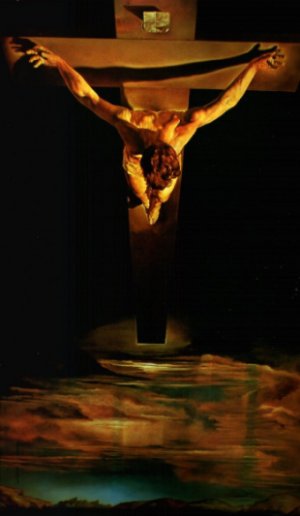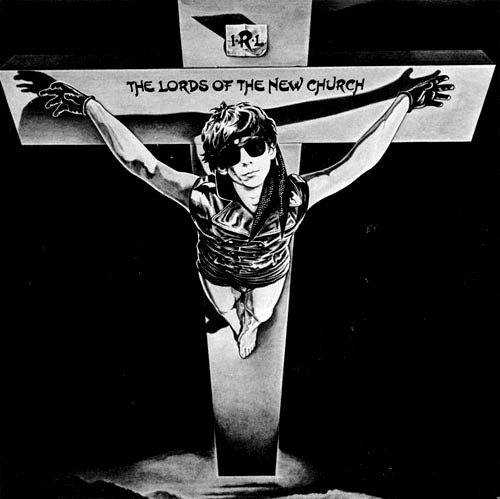Page 1 of 3
Posted: 20 Sep 2006, 10:23
by markfiend
eotunun wrote:I´m quite sure you all heard/read that historics tried to find out what Jesus of Nazareth was doing in his years that are not accounted for in the "holy" scriptures. It came out that he probably travelled with caravanes along the silk roads where he got into contact with buddhist monks and learnt the concept of love, peace and happiness..
Heh. There's quite a body of work (historical and text-critical) that suggests
Jesus never existed outside the scriptures. There are some problems with Doherty's thesis, but he makes a good case that the mythic redemptive 'Christ' in Paul's epistles and the teacher and prophet 'Jesus' in the sources for the Gospels didn't meet until the Gospel of Mark was written...
One interesting website goes into a very detailed commentary on the Gospel of Mark, upon which the other three depend, and calls it 'one of the great pieces of world literature'. IIRC Turton tentatively concludes that the Gospel of Mark was written as a play, intended to be performed (perhaps as a religious rite, perhaps to attract new converts to the fledgling religion)
Posted: 21 Sep 2006, 01:31
by boudicca
markfiend wrote:Heh. There's quite a body of work (historical and text-critical) that suggests
Jesus never existed outside the scriptures
Oh God.
Have you been talking to that ginger bloke out the Sisterhood?
I have had a look at the book, now I can't remember who wrote it, entitled "The Jesus Mysteries - was the original Jesus a Pagan god?"
I'm wary of this theory, but there was some quite compelling stuff in there. Even if Jesus was a genuine historical figure, it is still very interesting to look at him, and Christianity, with those ideas in mind.
Posted: 21 Sep 2006, 12:40
by markfiend
Well partly. I know the book you mean, by Freke and Gandy as I recall, but Earl Doherty's
The Jesus Puzzle is far more scholarly. He hasn't got a neo-gnostic agenda for one thing.
But the main points of the thesis (shamelessly nicked from the website referenced above)
- A CONSPIRACY OF SILENCE
The Gospel story, with its figure of Jesus of Nazareth, cannot be found before the Gospels. In Christian writings earlier than Mark, including almost all of the New Testament epistles, as well as in many writings from the second century, the object of Christian faith is never spoken of as a human man who had recently lived, taught, performed miracles, suffered and died at the hands of human authorities, or rose from a tomb outside Jerusalem. There is no sign in the epistles of Mary or Joseph, Judas or John the Baptist, no birth story, teaching or appointment of apostles by Jesus, no mention of holy places or sites of Jesus’ career, not even the hill of Calvary or the empty tomb. This silence is so pervasive and so perplexing that attempted explanations for it have proven inadequate.
- A MUTE RECORD WORLD WIDE
The first clear non-Christian reference to Jesus as a human man in recent history is made by the Roman historian Tacitus around 115 CE, but he may simply be repeating newly-developed Christian belief in an historical Jesus in the Rome of his day. Several earlier Jewish and pagan writers are notably silent. The Antiquities of the Jews by the Jewish historian Josephus, published in the 90s, contains two famous references to Jesus, but these are inconclusive. The first passage, as it stands, is universally acknowledged to be a later Christian insertion, and attempts have failed to prove some form of authentic original; the second also shows signs of later Christian tampering. References to Jesus in the Jewish Talmud are garbled and come from traditions which were only recorded in the third century and later.
- REVEALING THE SECRET OF CHRIST
Paul and other early writers speak of the divine Son of their faith entirely in terms of a spiritual, heavenly figure; they never identify this entity called "Christ Jesus" (literally, "Anointed Savior" or "Savior Messiah") as a man who had lived and died in recent history. Instead, through the agency of the Holy Spirit, God has revealed the existence of his Son and the role he has played in the divine plan for salvation. These early writers talk of long-hidden secrets being disclosed for the first time to apostles like Paul, with no mention of an historical Jesus who played any part in revealing himself, thus leaving no room for a human man at the beginning of the Christian movement. Paul makes it clear that his knowledge and message about the Christ is derived from scripture under God’s inspiration.
- A SACRIFICE IN THE SPIRITUAL REALM
Paul does not locate the death and resurrection of Christ on earth or in history. According to him, the crucifixion took place in the spiritual world, in a supernatural dimension above the earth, at the hands of the demon spirits (which many scholars agree is the meaning of "rulers of this age" in 1 Corinthians 2:8). The Epistle to the Hebrews locates Christ’s sacrifice in a heavenly sanctuary (ch. 8, 9). The Ascension of Isaiah, a composite Jewish-Christian work of the late first century, describes (9:13-15) Christ’s crucifixion by Satan and his demons in the firmament (the heavenly sphere between earth and moon). Knowledge of these events was derived from visionary experiences and from scripture, which was seen as a ‘window’ onto the higher spiritual world of God and his workings.
- SALVATION IN A LAYERED UNIVERSE
The activities of gods in the spiritual realm were part of ancient views (Greek and Jewish) of a multi-layered universe, which extended from the base world of matter where humans lived, through several spheres of heaven populated by various divine beings, angels and demons, to the highest level of pure spirit where the ultimate God dwelled. In Platonic philosophy (which influenced Jewish thought), the upper spiritual world was timeless and perfect, serving as a model for the imperfect and transient material world below; the former was the "genuine" reality, accessible to the intellect. Spiritual processes took place there, with their effects, including salvation, on humanity below. Certain "human characteristics" given to Christ (e.g., Romans 1:3) were aspects of his spirit world nature, higher counterparts to material world equivalents, and were often dependent on readings of scripture.
- A WORLD OF SAVIOR DEITIES
Christ’s features and myths are in many ways similar to those of the Greco-Roman salvation cults of the time known as "mystery religions", each having its own savior god or goddess. Most of these (e.g., Dionysos, Mithras, Attis, Isis, Osiris) were part of myths in which the deity had overcome death in some way, or performed some act which conferred benefits and salvation on their devotees. Such activities were viewed as taking place in the upper spirit realm, not on earth or in history. Most of these cults had sacred meals (like Paul’s Lord’s Supper in 1 Corinthians 11:23f) and envisioned mystical relationships between the believer and the god similar to what Paul speaks of with Christ. Early Christianity was a Jewish sectarian version of this widespread type of belief system, though with its own strong Jewish features and background.
- THE INTERMEDIARY SON
The Christian "Son" is also an expression of the overriding religious concept of the Hellenistic age, that the ultimate God is transcendent and can have no direct contact with the world of matter. He must reveal himself and deal with humanity through an intermediary force, such as the "Logos" of Platonic (Greek) philosophy or the figure of "personified Wisdom" of Jewish thinking; the latter is found in documents like Proverbs, Baruch and the Wisdom of Solomon. This force was viewed as an emanation of God, his outward image, an agency which had helped create and sustain the universe and now served as a channel of knowledge and communion between God and the world. All these features are part of the language used by early Christian writers about their spiritual "Christ Jesus", a heavenly figure who was a Jewish sectarian version of these prevailing myths and thought patterns.
- A SINGLE STORY OF JESUS
All the Gospels derive their basic story of Jesus of Nazareth from a single source: whoever produced the first version of Mark. That Matthew and Luke are reworkings of Mark with extra, mostly teaching, material added is now an almost universal scholarly conclusion, while many also consider that John has drawn his framework for Jesus’ ministry and death from a Synoptic source as well. We thus have a Christian movement spanning half the empire and a full century which nevertheless has managed to produce only one version of the events that are supposed to lie at its inception. Acts, as an historical witness to Jesus and the beginnings of the Christian movement, cannot be relied upon, since it is a tendentious creation of the second century, dependent on the Gospels and designed to create a picture of Christian origins traceable to a unified body of apostles in Jerusalem who were followers of an historical Jesus. Many scholars now admit that much of Acts is sheer fabrication.
- THE GOSPELS AS (FICTIONAL) "MIDRASH"
Not only do the Gospels contain basic and irreconcilable differences in their accounts of Jesus, they have been put together according to a traditional Jewish practice known as "midrash", which involved reworking and enlarging on scripture. This could entail the retelling of older biblical stories in new settings. Thus, Mark’s Jesus of Nazareth was portrayed as a new Moses, with features that paralleled the stories of Moses. Many details were fashioned out of specific passages in scripture. The Passion story itself is a pastiche of verses from the Psalms, Isaiah and other prophets, and as a whole it retells a common tale found throughout ancient Jewish writings, that of the Suffering and Vindication of the Innocent Righteous One. It is quite possible that Mark, at least, did not intend his Gospel to represent an historical figure or historical events, and designed it to provide liturgical readings for Christian services on the Jewish model. Liberal scholars now regard the Gospels as "faith documents" and not accurate historical accounts.
- THE COMMUNITY OF "Q"
In Galilean circles distinct from those of the evangelists (who were probably all located in Syria), a Jewish movement of the mid-first century preaching the coming of the Kingdom of God put together over time a collection of sayings, ethical and prophetic, now known as Q. The Q community eventually invented for itself a human founder figure who was regarded as the originator of the sayings. In ways not yet fully understood, this figure fed into the creation of the Gospel Jesus, and the sayings document was used by Matthew and Luke to flesh out their reworking of Mark’s Gospel. Some modern scholars believe they have located the "genuine" Jesus at the roots of Q, but Q’s details and pattern of evolution suggest that no Jesus was present in its earlier phases, and those roots point to a Greek style of teaching known as Cynicism, one unlikely to belong to any individual, let alone a Jewish preacher of the Kingdom.
- A RIOTOUS DIVERSITY
The documentary record reveals an early Christian landscape dotted with a bewildering variety of communities and sects, rituals and beliefs about a Christ/Jesus entity, most of which show little common ground and no central authority. Also missing is any idea of apostolic tradition tracing back to a human man and his circle of disciples. Scholars like to style this situation as a multiplicity of different responses to the historical Jesus, but such a phenomenon is not only incredible, it is nowhere attested to in the evidence itself. Instead, all this diversity reflects independent expressions of the wider religious trends of the day, based on expectation of God’s Kingdom, and on belief in an intermediary divine force which provided knowledge of God and a path to salvation. Only with the Gospels, which began to appear probably toward the end of the first century, were many of these elements brought together to produce the composite figure of Jesus of Nazareth, set in a midrashic story about a life, ministry and death located in the time of Herod and Pontius Pilate.
- JESUS BECOMES HISTORY
As the midrashic nature of the Gospels was lost sight of by later generations of gentile Christians, the second century saw the gradual adoption of the Gospel Jesus as an historical figure, motivated by political considerations in the struggle to establish orthodoxy and a central power amid the profusion of early Christian sects and beliefs. Only with Ignatius of Antioch, just after the start of the second century, do we see the first expression in Christian (non-Gospel) writings of a belief that Jesus had lived and died under Pilate, and only toward the middle of that century do we find any familiarity in the wider Christian world with written Gospels and their acceptance as historical accounts. Many Christian apologists, however, even in the latter part of the century, ignore the existence of a human founder in their picture and defense of the faith. By the year 200, a canon of authoritative documents had been formed, reinterpreted to apply to the Jesus of the Gospels, now regarded as a real historical man. Christianity entered a new future founded on a monumental misunderstanding of its own past.
THE ASSEMBLED PUZZLE
Modern critical scholars have been dismantling the story of Jesus, attempting to salvage from it an inspiring sage for a more rational, enlightened future, and letting go the sacrificial divine Savior of an archaic past. Some of them are edging toward the admission that Paul's Christ had nothing to do with an historical man, while positioning their new teaching Jesus as only one element in the Jewish-Hellenistic synthesis which led to Christianity. The sage, however, is an artificial construct, a misreading (then and now) of the broader sectarian expressions of the day. And the links and lines of development between the various strands which scholars have created to make their scenarios hang together are largely unsupported by the evidence. The pieces of the Jesus Puzzle will not fit together except by abandoning any expectation of encountering an historical, human face.
Posted: 21 Sep 2006, 13:11
by wild bill buttock
Posted: 21 Sep 2006, 13:55
by markfiend
wild bill buttock wrote:
It's
SUPERJESUS! 
Posted: 21 Sep 2006, 16:10
by Thea
markfiend wrote:wild bill buttock wrote:
It's
SUPERJESUS! 
I recently inherited a load of pictures of The Jesus and I wish that had been one of them

Posted: 21 Sep 2006, 19:22
by mh
markfiend wrote:wild bill buttock wrote:
It's
SUPERJESUS! 
Jesus Schwartznegger wrote:I'LL BE BACK
Posted: 21 Sep 2006, 19:57
by weebleswobble
boudicca wrote:
Oh God.
Have you been talking to that ginger bloke out the Sisterhood?
We are Legion

Posted: 21 Sep 2006, 20:40
by Planet Dave
God, Jesus, Allah, David Icke, it's all a bit of a fcuking worry really, isn't it?
Posted: 21 Sep 2006, 23:17
by James Blast

nuff said <sniff> and I've seen it in the flesh, before and after slash
Posted: 21 Sep 2006, 23:18
by Thea
Planet Dave wrote:God, Jesus, Allah, David Icke, it's all a bit of a fcuking worry really, isn't it?
That's where
The Flying Spaghetti Monster comes into it...
Go forth and be touched by his noodly appendage - you know it makes sense!
Posted: 21 Sep 2006, 23:22
by weebleswobble
d00mw0lf wrote:Planet Dave wrote:God, Jesus, Allah, David Icke, it's all a bit of a fcuking worry really, isn't it?
That's where
The Flying Spaghetti Monster comes into it...
Go forth and be touched by his noodly appendage - you know it makes sense!
The Internetty is a strange and unusual place, an
Acoustic Garden of the Cyberworld......

Posted: 21 Sep 2006, 23:33
by nick the stripper
James Blast wrote:
nuff said <sniff> and I've seen it in the flesh, before and after slash
What's Saul Hudson got to do with Jesus?
Posted: 21 Sep 2006, 23:37
by mh
James Blast wrote:
nuff said <sniff> and I've seen it in the flesh, before and after slash
"Peter... Peter... come to me..."
"Peter... on your rock I will build my church..."
"John... John... come to me..."
"John... you will inherit the kingdom of heaven..."
"Thomas... Thomas... come to me..."
"Thomas... I can see your house from up here!"
I'm going to burn, aren't I?
Posted: 21 Sep 2006, 23:43
by nick the stripper
mh wrote:
I'm going to burn, aren't I?
With the best of them: Andrew Eldritch, William Burroughs, Ginsberg, Goethe, Nietzsche, Buddha, etc, etc.
Honestly, if I had to choose between an eternity without god (which is what hell is), or an eternity serving god with a bunch of assholes I couldn't stand in this life (you're void from this Blast, you're not one of the 'in your face' assholes I have to deal with daily), I'd choose hell.
Posted: 21 Sep 2006, 23:50
by Nic
And then there is a different kind of church


Posted: 21 Sep 2006, 23:52
by weebleswobble
Nic wrote:And then there is a different kind of church


A tripod?

Posted: 21 Sep 2006, 23:52
by James Blast
to each, their own
I am no preacher, but read more Bill Bryson and listen to early <fill in English ProgRock combo name, like Genesis/Hawkwind/Gentle Giant/Yes/Roxy Music/Family/The Pink Floyd/ELP etc.>, please 
Posted: 21 Sep 2006, 23:58
by weebleswobble
Posted: 21 Sep 2006, 23:58
by Nic
weebleswobble wrote:Nic wrote:And then there is a different kind of church


A tripod?

You mean well-hung?

Posted: 22 Sep 2006, 00:01
by Nic
weebleswobble wrote:James Blast wrote:to each, their own
I am no preacher, but read more Bill Bryson and listen to early <fill in English ProgRock combo name, like Genesis/Hawkwind/Gentle Giant/Yes/Roxy Music/Family/The Pink Floyd/ELP etc.>, please 

Keep talking!

Posted: 22 Sep 2006, 00:23
by weebleswobble

He's your
Buddy
Posted: 22 Sep 2006, 01:50
by 9while9
It's just like Adam says
It's not so hard to understand
It's just like always coming down on
Just like Jesus never came and
What did you expect to find
It's just like always here again it's...
Posted: 22 Sep 2006, 01:59
by weebleswobble
9while9 wrote:It's just like Adam says
It's not so hard to understand
It's just like always coming down on
Just like Jesus never came and
What did you expect to find
It's just like always here again it's...
Did you get that off a greeting card?
Posted: 22 Sep 2006, 02:39
by DarkAngel
"The religious nutballs on the extreme right have kept us rational lefties so busy that we've neglected an important although onerous duty -- cleaning the atheist whackjobs out of our own attic, the extreme left. (Of course, extremisms of the religious or atheistic nature are only a small part of the sum total of extremism. Every form of thought has its own whackjobs of varying stripes.)
Why face off with the atheist whackjobs? Because extremism is extremism is extremism. No rational movement dedicated to intellectual courage and honesty should maintain a relationship with those for whom intellectual laziness, dishonesty, and cowardice are a way of life. Doing what must be done to insure the integrity of the left will require identifying our extremists, countering their mythologies, and acknowledging the dangers they pose to a truly liberal society.
First, what is an atheist whackjob? The term secular for the purposes of this article will refer to those who disbelieve all religious and spiritual claims, not to those who merely support a separation of church and state. Although all secular (by this definition) extremists are atheists, not all atheists are atheist extremists.
The whackjob is a special sort of atheist, one so absolutely certain of the inerrancy of atheism and so virulently opposed to religion that he will latch on to any and all outrageous claims in defense of the former and against the latter. He will meet any criticism of atheism or positive representation of religion as a horrible attack on his way of life or as support for religious extremism and oppression. Just as the religious extremist holds that his belief in a supreme being alone makes him morally and spiritually superior, the atheist extremist holds that his belief that no such being exists and virulent opposition to the reverse make him intellectually and ethically superior. Finally, he will ignore any and all reason or evidence that refutes his claims.
So, what are the atheist extremist's claims? They are legion, but I will stick to some of the major claims I've encountered in "respected" secularist media and in debate with atheist friends and readers.
Outrageous claim number 1: Atheism is based on evidence and reason and is philosophically provable or proven. Atheism is a matter of thought not belief. In other words, atheism is true; religion is false. "
For the rest of the article go to:
http://www.rawstory.com/news/2006/The_l ... _0422.html





